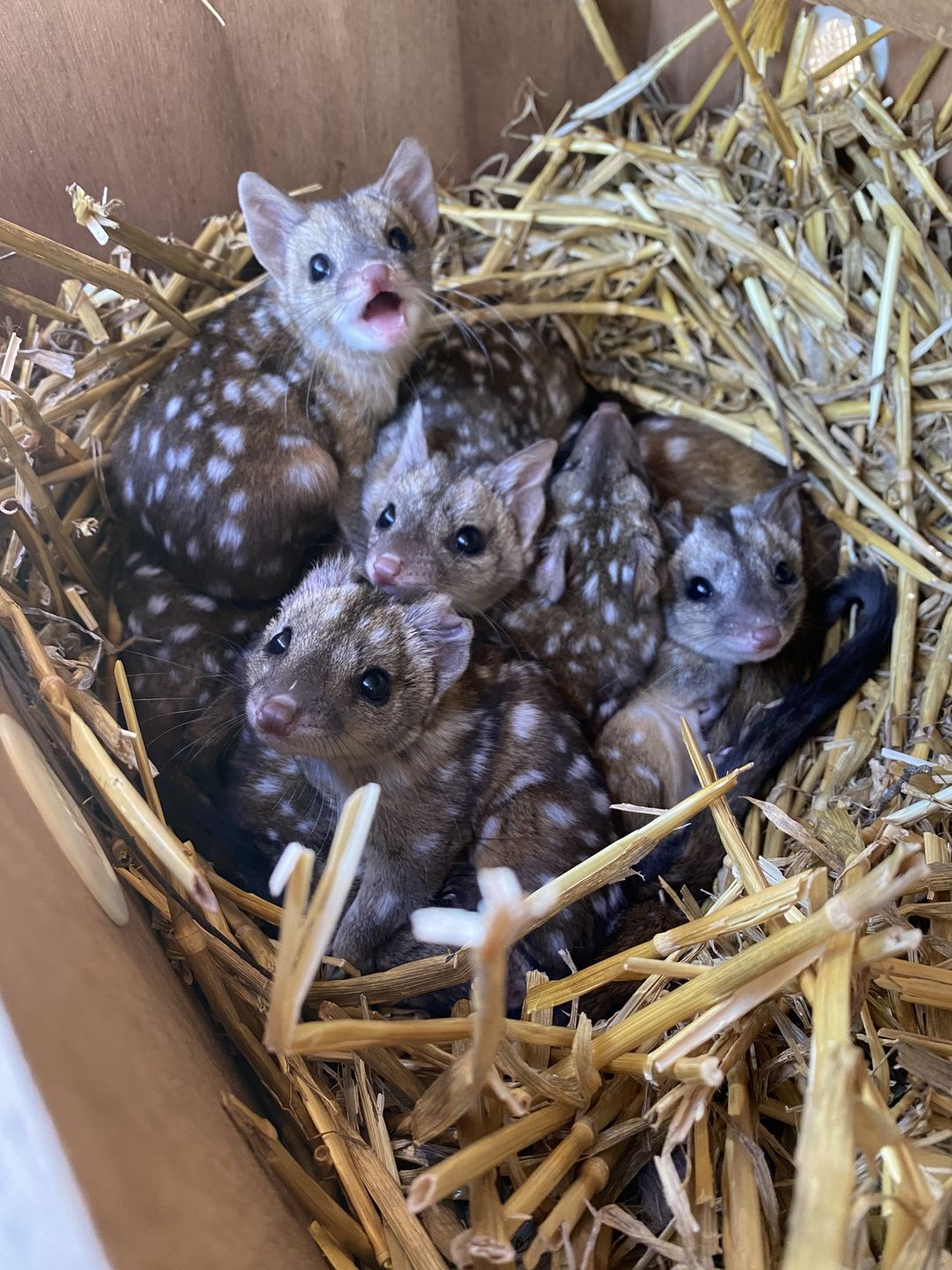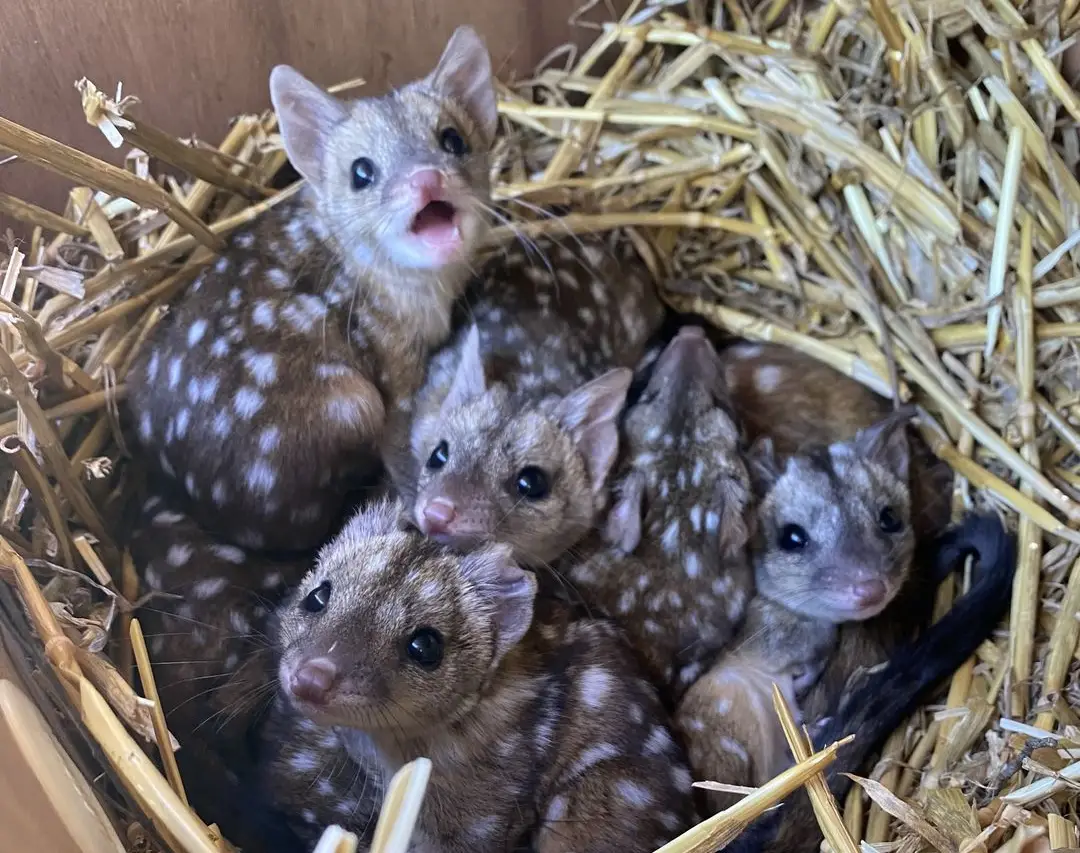In an exciting and heartwarming turn of events, a group of researchers in Australia has made a stunning discovery that brings renewed hope for a species that was once thought to be on the brink of extinction. Ecologists at the Mt. Gibson Wildlife Sanctuary recently encountered a litter of newborn creatures with spiky little features, leading them to make an astonishing realization about their identity—and the implications for conservation efforts.
The creatures in question belong to the western quoll, a type of marsupial carnivore that has long been in danger of disappearing from the Australian landscape.

The Western Quoll: A Struggle for Survival
Once widespread across much of Australia, the western quoll, also known as the chuditch, has experienced a dramatic decline since European settlers first arrived on the continent. Over the years, the species has seen its range shrink significantly, and today, the western quoll can only be found in small pockets in the southwestern corner of Australia.
Growing to about the size of a domestic cat, the western quoll plays a crucial role in maintaining the balance of its ecosystem. As a marsupial carnivore, it preys on smaller invertebrates, certain reptiles, and even birds. Its presence helps control populations of these species, contributing to the overall health of the environment.
However, the western quoll’s role in the ecosystem has been jeopardized by habitat loss, the introduction of invasive predators like foxes and feral cats, and the encroachment of urban development.
A Ray of Hope: The Reintroduction Effort
In recent years, researchers have made it a priority to revive the western quoll population, particularly in areas where the species has disappeared. A significant effort has been underway to reintroduce the quolls to the Mt. Gibson Wildlife Sanctuary, a remote area where they were previously thought to be extinct.
With the ongoing reintroduction program, the sanctuary’s researchers had high hopes but were uncertain about the outcome. The idea was to create a safe environment for the quolls to thrive, with no immediate threats from human activity or predatory species. By carefully monitoring the animals, providing them with adequate food sources, and ensuring that they had the resources they needed, researchers hoped to give the quolls a fighting chance at survival.
And now, it seems that the program has borne fruit.

A Thrilling Discovery: Baby Quolls in the Sanctuary
The recent discovery of a litter of newborn quolls at the Mt. Gibson Wildlife Sanctuary was nothing short of thrilling. These spiky little creatures were a clear sign that the quolls had successfully adapted to their new home, and perhaps even more importantly, they had begun to reproduce in the wild once again. This marks a significant step forward in the conservation of the species, as the ability to breed in their new environment is essential for long-term survival.
The baby quolls, still in the pouch stage, are a symbol of hope for the future of the species. Researchers are celebrating this milestone, as it suggests that the western quolls are not only surviving but thriving in the sanctuary.
Georgina Anderson, Senior Field Ecologist at AWC (Australian Wildlife Conservancy), shared her excitement about the discovery. “Through regular monitoring, we can see the quolls are doing well at the sanctuary and encountering the first pouch young is a positive sign that they have adjusted to the new environment,” Anderson explained. “One quoll that we’ve named Aang is a regular at camera traps we set up at the release sites. He is one of our largest and most striking quolls with a personality to match – often making rounds of multiple sites to collect the chicken we use as lures and disrupting our bait canisters,” she added.
Aang, one of the sanctuary’s most notable quolls, has become a bit of a local celebrity among the researchers, thanks to his distinctive behavior. His appearances on camera traps have been both informative and entertaining, providing valuable insight into the quolls’ activities in their new environment.
A Brighter Future for the Western Quoll
The discovery of the baby quolls is an incredibly positive sign for the species, indicating that their reintroduction is a success. If the quolls can continue to thrive and reproduce at Mt. Gibson Wildlife Sanctuary, there is a real possibility that their population will grow, eventually allowing for further reintroductions into other parts of Australia.
This is particularly exciting because the western quoll is a species of great ecological importance. If they can reclaim their place in the ecosystem, they can help restore balance and contribute to the health of the broader environment.
The success at Mt. Gibson offers hope that, with the right conservation efforts, we can reverse some of the damage done to Australia’s native wildlife. It also highlights the incredible resilience of species like the western quoll, which, despite facing significant challenges, can still recover if given the chance.
The Road Ahead: Expansion and Ongoing Monitoring
Looking forward, conservationists are optimistic that the western quolls will continue to thrive in the sanctuary. However, this success is just the beginning. Researchers are committed to monitoring the quoll population closely and ensuring that the environment remains suitable for their survival.
Future efforts may involve expanding the sanctuary’s range to include other suitable habitats in Australia, as well as exploring how the quolls can be safely reintroduced into areas where they have been absent for decades.
Additionally, the knowledge gained from this reintroduction effort will be invaluable in guiding future conservation programs for other endangered species in Australia. The success of the western quoll can serve as a model for how we can help protect other vulnerable animals and restore ecosystems that have been damaged by human activity and invasive species.
Conclusion: A Triumph for Conservation
The birth of baby western quolls at the Mt. Gibson Wildlife Sanctuary is a beacon of hope for this once-endangered species. Through the dedication and hard work of researchers, conservationists, and the community, the western quoll is making a remarkable comeback.
As we celebrate this success, we are reminded of the critical importance of conservation efforts in protecting the planet’s biodiversity. The quoll’s recovery is proof that with determination, careful planning, and ongoing support, we can make a real difference in the fight to protect endangered species.
For now, the future of the western quoll looks brighter than ever, and researchers remain hopeful that this success will extend far beyond the sanctuary, ensuring that the quolls will once again roam freely across Australia. Let’s continue to support these efforts and spread the word about the incredible work being done to save this unique species.

